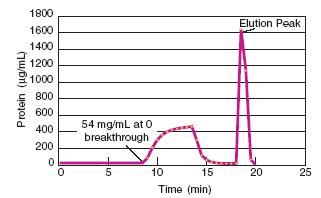For Biomolecule Capture



Pall's family of ion exchange membranes utilizes the principles of sorbent-based ion exchange chromatography on flat stock membrane. This provides ease-of-use and handling benefits over resin-based slurries in a manufacturing environment. Our ion exchange membranes deliver efficient and rapid flow rates with a convective pore structure resulting in processing times that are much shorter and more efficient than conventional resin-based technologies even when purifying large molecules such as plasmids and viruses. Optimization of our ion exchange membranes has resulted in throughputs of up to 100 times that of traditional resin-based media with no associated loss of capacity.
Our ion exchange membranes are available in three chemistries: Q, S, and E (for endotoxin removal). The strong anion exchange membrane (Q chemistry) is ideal for the capture/release of plasmid DNA, virus or target proteins from a complex mixture. The Q chemistry is also well suited for purifying oligos and the protein polishing of negatively-charged proteins. The strong cation exchange membrane (S chemistry) purifies and concentrates positively-charged proteins and viral particles. The endotoxin removal membrane (E chemistry) features a proprietary surface modification that effectively removes endotoxin from water, buffers, neutral sugars, and certain biological solutions. The endotoxin removal capacity may vary by flow rate, protein surface charge, type and concentration of protein, pH, salt concentration, or other components of the sample solution such as surfactants and glycols.
Note: The capture of biomolecules is typically done in the presence of low salt. Due to the nature of our ion exchange membranes, they are more salt sensitive than the same chemistries on beads. This should be considered when choosing the buffers for capture and elution.
Typical Membrane Characteristics
| Base Material | Thickness (mils) | Thickness (µm) |
| Anionic Exchange (Q) | 4.7-6.3 | 119.4-160.0 |
| Cationic exchange (S) | 4.5-6.3 | 114.3-160.0 |
Typical Performance Characteristics
| Base Material | Dynamic DNA Binding Capacity (mg/mL) | Water Bubble Point (psi) | Water Bubble Point (bar) | Dynamic Protein Binding (mg/mL) | Water Flow (mL/min/cm2 @ 0.7 bar, 10 psi) | |
| Anionic Exchange (Q) | > 12.0 | N/A | N/A | > 30.0 | 30.0-140.0 | |
| Cationic exchange (S) | N/A | N/A | N/A | > 30.0 | > 36.0 | |
Applications
- Biomolecule capture
- Plasmid preparation
Sealing
- Mechanical
- Heat
- Ultrasonic
- RF welding
- Insert molding
Acrodisc® Unit with Anion Exchange (Q) Membrane: Dynamic Binding with BSA
A solution of 0.524 mg/mL BSA was pumped through the Acrodisc unit at 2.3 mL/min. Breakthrough occurred at 8.1 minutes and was calculated as 54 mg/mL using:
Flow Rate (2.3 mL/min) X Initial Protein BSA Concentration (0.524 mg/mL) X time (8.1 min)
---------------------------------------------------------------------------------------------------------------------------
Membrane Bed Volume of Anion Exchange Membrane in 25 mm Acrodisc Unit (0.18 mL)
The Acrodisc name is a registered trademark of Pall Corporation and is not available for use.
Custom roll, sheet, and disc sizes available upon request. Please contact your local sales representative for additional information.
| Part Number | Description | Pkg |
|---|---|---|
| S80574 | Mustang Anionic Exchange (Q) membrane, 8" x 10" sheet | 1/pkg |
| S80570 | Mustang Cationic Exchange (S) membrane, 8" x 10" sheet | 1/pkg |
The Mustang name is a registered trademark of Pall Corporation and is not available for use.
Products in this datasheet may be covered by one or more patents including EP 1,163, 045; EP 1,614,459; US 6,780,327; US 6,851,561; US 7,094,347; US 7,223,341; EP 1,163,044; US 6,783,937,US 6,860,393; and US 7,132,049.
Earn 10% off* your next order online by leaving a review of this product. Please login to your account to leave a review. We appreciate and value your feedback.
*Subject to Terms and Conditions.





